Open-Source Vertical Swinging Wood-Based Solar Photovoltaic Racking Systems
Abstract
1. Introduction
2. Materials and Methods
2.1. System Design and Assembly
2.1.1. Material Selection
2.1.2. Bill of Materials
2.1.3. Assembly Instructions
2.2. Energy Performance and Cost Analysis
3. Results
3.1. Cost with Scaling
3.2. Energy Performance and Cost Analysis Results
4. Discussion
4.1. Limitations and Future Work
4.2. Wood Price Sensitivity
5. Conclusions
6. OSHWA Certification in Place of Patents
Author Contributions
Funding
Institutional Review Board Statement
Informed Consent Statement
Data Availability Statement
Conflicts of Interest
Appendix A. Specified Loads
Appendix B. Vertical System Structural Analysis




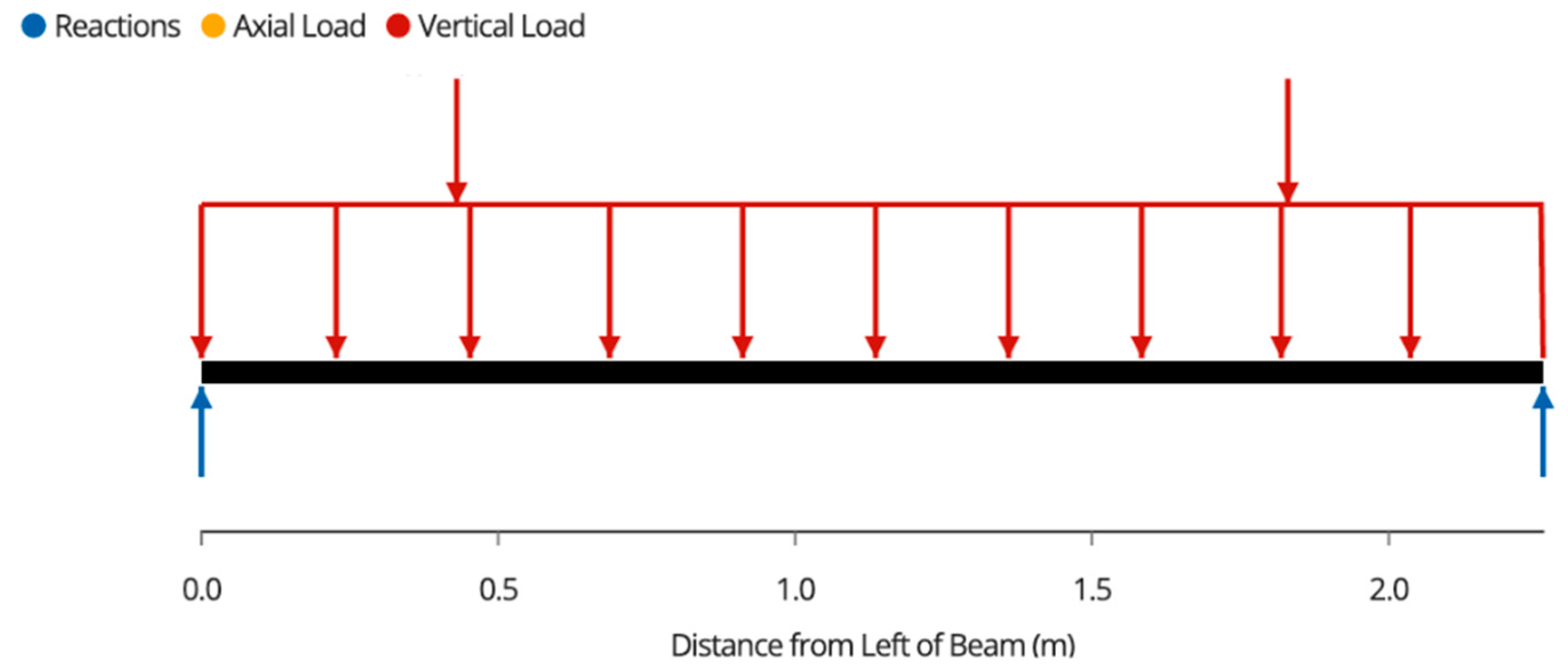




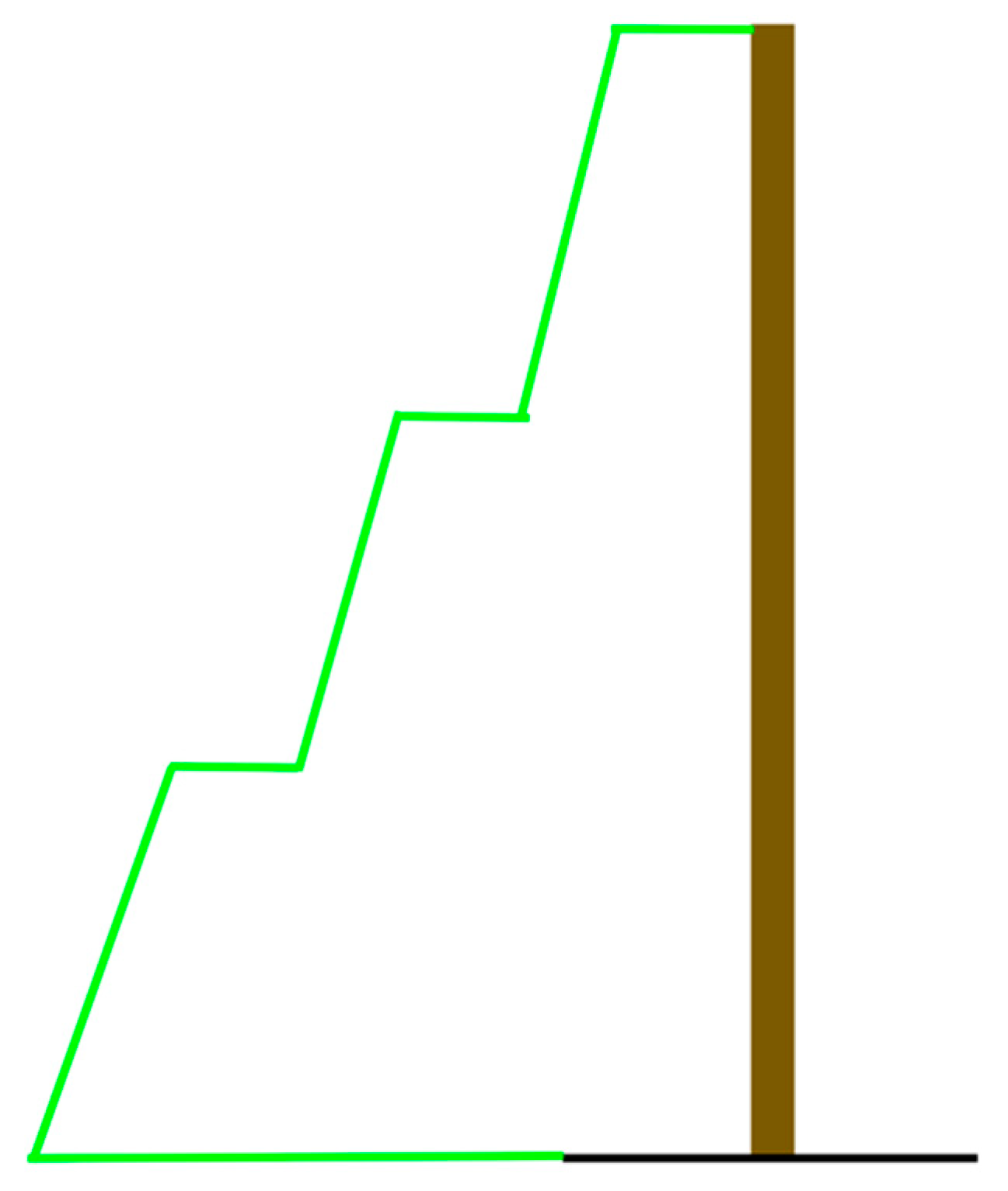
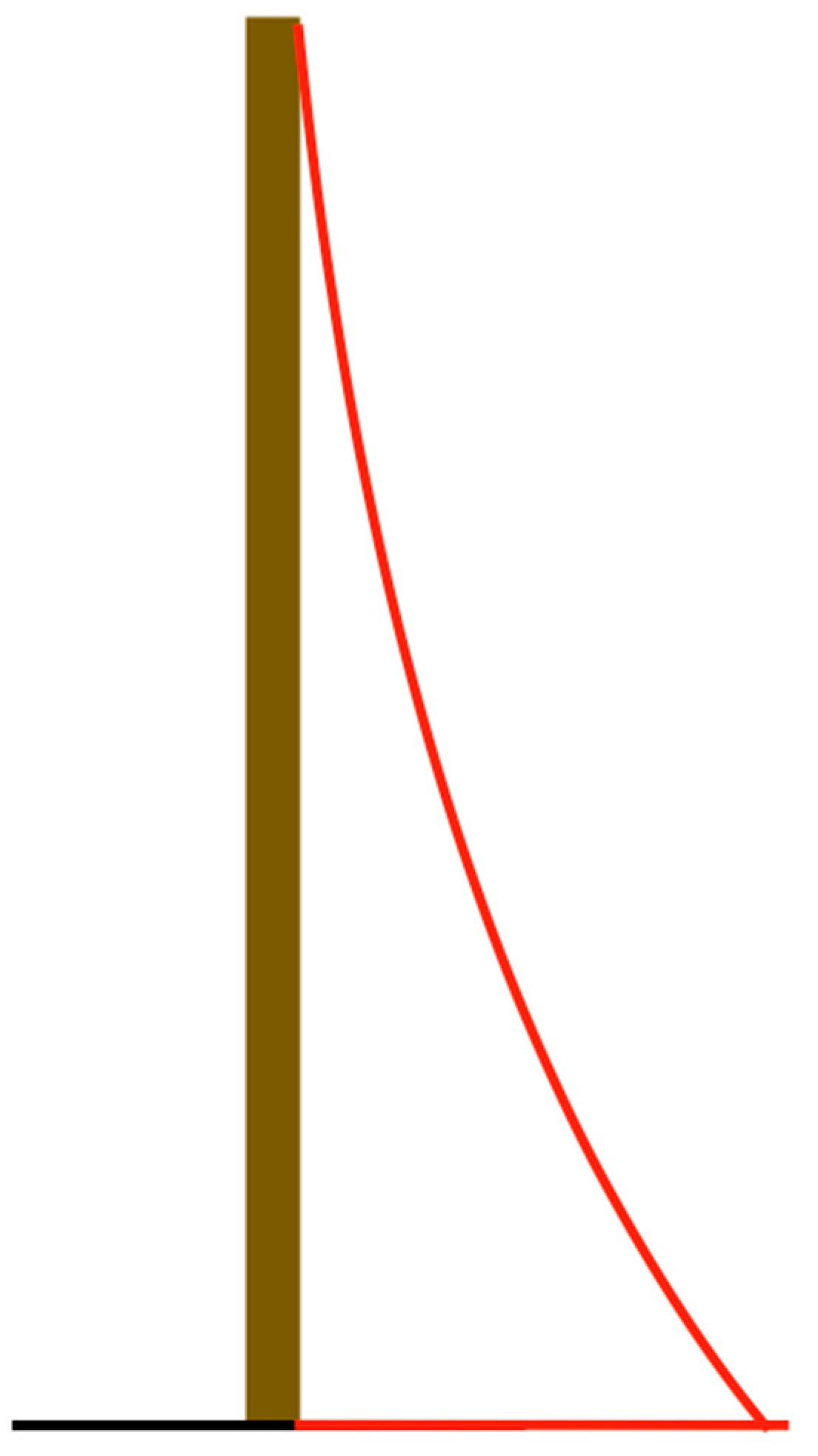
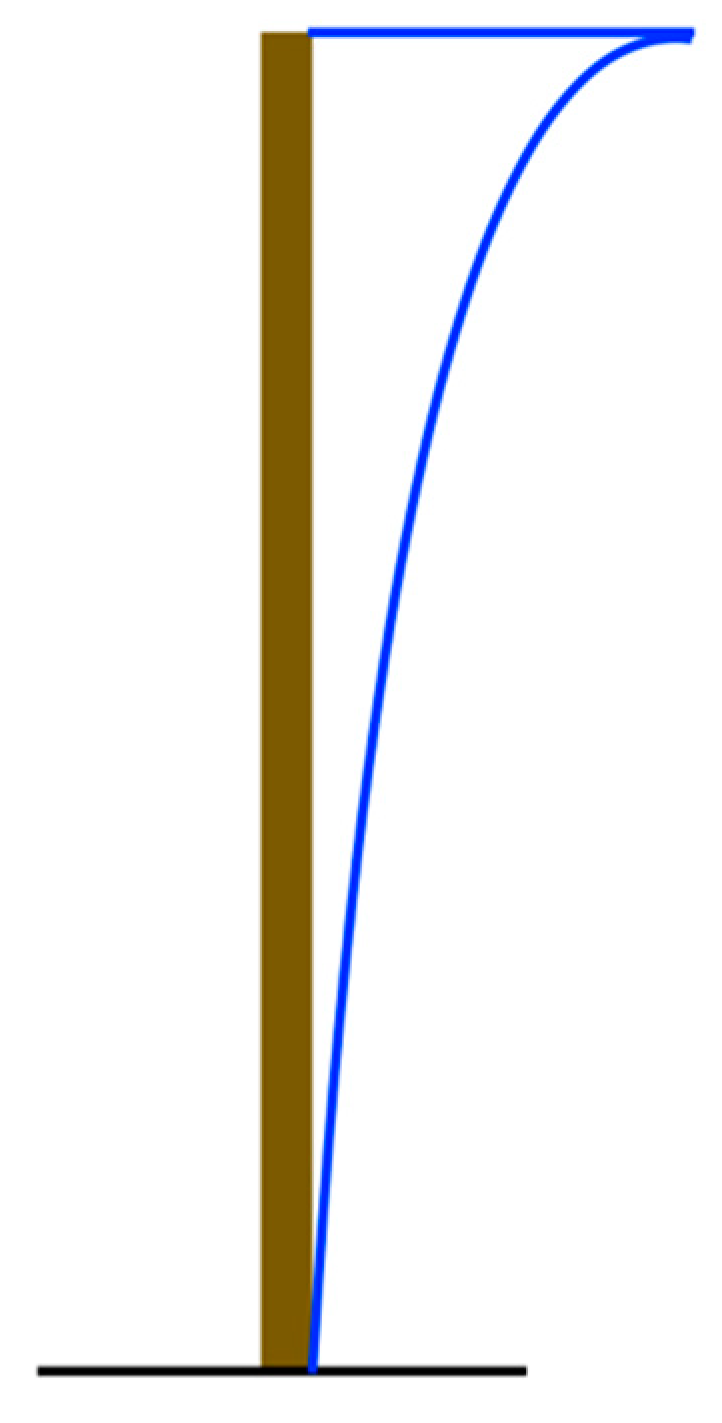

| Lumber | Shear [kN] | Moment [kNm] | Deflection [mm] | Compression [kN] | Stress [MPa] |
|---|---|---|---|---|---|
| 2 × 4 Wind | 0.05 | 0.03 | 22.24 | N/A | 1.47 |
| 2 × 4 Weight | 0.13 | 0.07 | 2.92 | N/A | 1.56 |
| Outside 6 × 6 | 0.41 | 0.83 | 0.02 | 0.39 | 1.93 |
| Inside 6 × 6 | 0.58 | 1.26 | 0.01 | 0.79 | 2.80 |
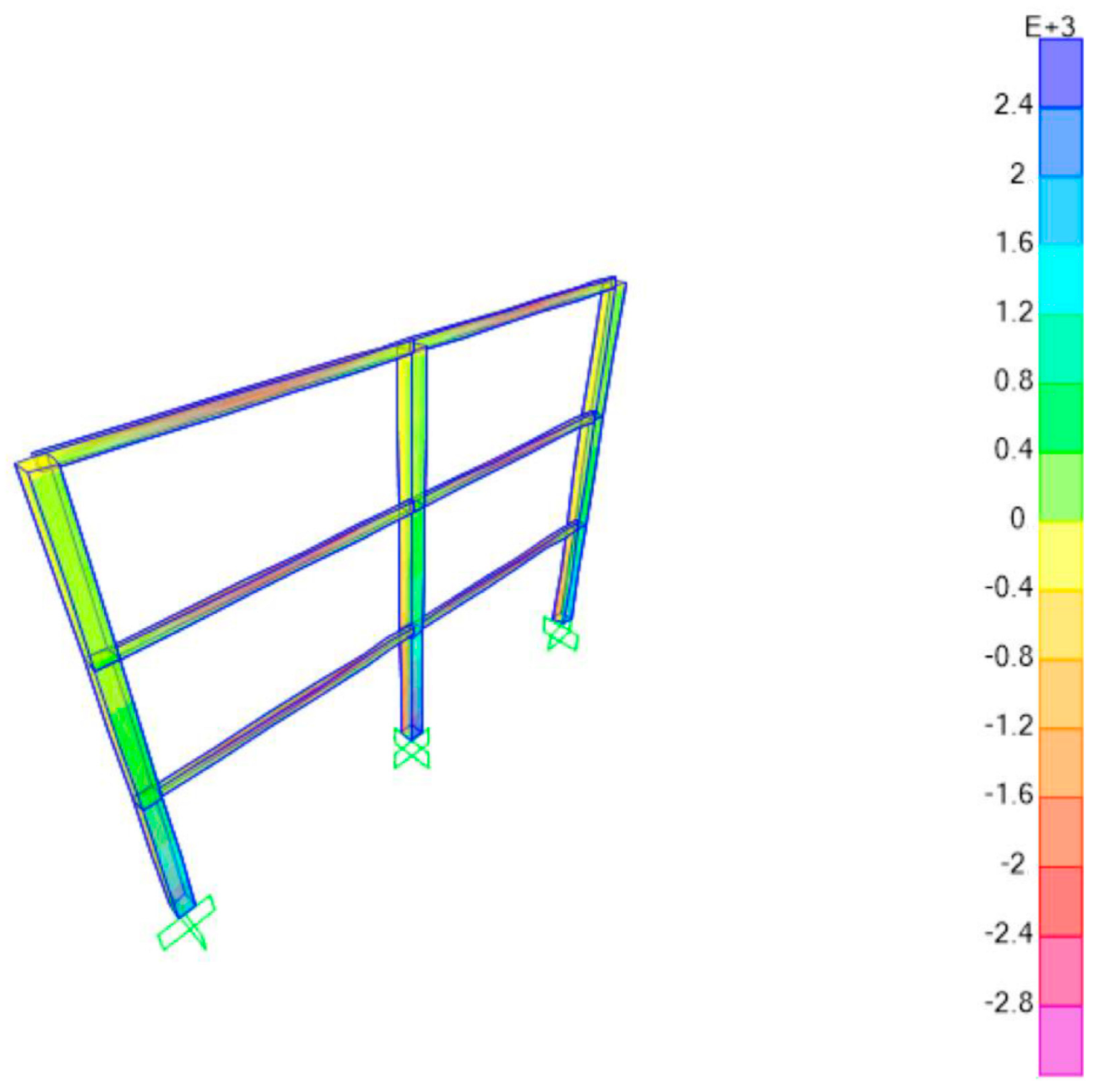
References
- CSIRO GenCost: Annual Electricity Cost Estimates for Australia. Available online: https://www.csiro.au/en/research/technology-space/energy/energy-data-modelling/gencost-2021-22 (accessed on 10 January 2023).
- Pearce, J.; Lau, A. Net Energy Analysis for Sustainable Energy Production from Silicon Based Solar Cells. In Proceedings of the Solar Energy; ASMEDC: Reno, NV, USA, 2002; pp. 181–186. [Google Scholar]
- Bhandari, K.P.; Collier, J.M.; Ellingson, R.J.; Apul, D.S. Energy Payback Time (EPBT) and Energy Return on Energy Invested (EROI) of Solar Photovoltaic Systems: A Systematic Review and Meta-Analysis. Renew. Sustain. Energy Rev. 2015, 47, 133–141. [Google Scholar] [CrossRef]
- Denholm, P.; Margolis, R.M. Land-Use Requirements and the per-Capita Solar Footprint for Photovoltaic Generation in the United States. Energy Policy 2008, 36, 3531–3543. [Google Scholar] [CrossRef]
- Wüstenhagen, R.; Wolsink, M.; Bürer, M.J. Social Acceptance of Renewable Energy Innovation: An Introduction to the Concept. Energy Policy 2007, 35, 2683–2691. [Google Scholar] [CrossRef]
- Batel, S.; Devine-Wright, P.; Tangeland, T. Social Acceptance of Low Carbon Energy and Associated Infrastructures: A Critical Discussion. Energy Policy 2013, 58, 1–5. [Google Scholar] [CrossRef]
- Calvert, K.; Mabee, W. More Solar Farms or More Bioenergy Crops? Mapping and Assessing Potential Land-Use Conflicts among Renewable Energy Technologies in Eastern Ontario, Canada. Appl. Geogr. 2015, 56, 209–221. [Google Scholar] [CrossRef]
- Calvert, K.; Pearce, J.M.; Mabee, W.E. Toward Renewable Energy Geo-Information Infrastructures: Applications of GIScience and Remote Sensing That Build Institutional Capacity. Renew. Sustain. Energy Rev. 2013, 18, 416–429. [Google Scholar] [CrossRef]
- Groesbeck, J.G.; Pearce, J.M. Coal with Carbon Capture and Sequestration Is Not as Land Use Efficient as Solar Photovoltaic Technology for Climate Neutral Electricity Production. Sci. Rep. 2018, 8, 13476. [Google Scholar] [CrossRef]
- Runge, C.F.; Senauer, B. How biofuels could starve the poor. Foreign Aff. 2007, 86, 41. [Google Scholar]
- Tenenbaum, D.J. Food vs. Fuel: Diversion of Crops Could Cause More Hunger. Environ. Health Perspect. 2008, 116, A254–A257. [Google Scholar] [CrossRef]
- Tomei, J.; Helliwell, R. Food versus Fuel? Going beyond Biofuels. Land Use Policy 2016, 56, 320–326. [Google Scholar] [CrossRef]
- Sovacool, B. Exploring and Contextualizing Public Opposition to Renewable Electricity in the United States. Sustainability 2009, 1, 702–721. [Google Scholar] [CrossRef]
- Sovacool, B.K.; Lakshmi Ratan, P. Conceptualizing the Acceptance of Wind and Solar Electricity. Renew. Sustain. Energy Rev. 2012, 16, 5268–5279. [Google Scholar] [CrossRef]
- Dias, L.; Gouveia, J.P.; Lourenço, P.; Seixas, J. Interplay between the Potential of Photovoltaic Systems and Agricultural Land Use. Land Use Policy 2019, 81, 725–735. [Google Scholar] [CrossRef]
- Dupraz, C.; Marrou, H.; Talbot, G.; Dufour, L.; Nogier, A.; Ferard, Y. Combining Solar Photovoltaic Panels and Food Crops for Optimising Land Use: Towards New Agrivoltaic Schemes. Renew. Energy 2011, 36, 2725–2732. [Google Scholar] [CrossRef]
- Mavani, D.D.; Chauhan, P.M.; Joshi, V.P. Beauty of Agrivoltaic System Regarding Double Utilization of Same Piece of Land for Generation of Electricity & Food Production. Int. J. Sci. Eng. Res. V 2019, 10, 118. [Google Scholar]
- Pearce, J.M. Photovoltaics—A Path to Sustainable Futures. Futures 2002, 34, 663–674. [Google Scholar] [CrossRef]
- Fthenakis, V.M.; Betita, R.; Shields, M.; Vinje, R.; Blunden, J. Life Cycle Analysis of High-Performance Monocrystalline Silicon Photovoltaic Systems: Energy Payback Times and Net Energy Production Value. In Proceedings of the 27th European Photovoltaic Solar Energy Conference and Exhibition, Frankfurt, Germany, 24 September 2012; pp. 4667–4672. [Google Scholar] [CrossRef]
- Marrou, H.; Wery, J.; Dufour, L.; Dupraz, C. Productivity and Radiation Use Efficiency of Lettuces Grown in the Partial Shade of Photovoltaic Panels. Eur. J. Agron. 2013, 44, 54–66. [Google Scholar] [CrossRef]
- Valle, B.; Simonneau, T.; Sourd, F.; Pechier, P.; Hamard, P.; Frisson, T.; Ryckewaert, M.; Christophe, A. Increasing the Total Productivity of a Land by Combining Mobile Photovoltaic Panels and Food Crops. Appl. Energy 2017, 206, 1495–1507. [Google Scholar] [CrossRef]
- Barron-Gafford, G.A.; Pavao-Zuckerman, M.A.; Minor, R.L.; Sutter, L.F.; Barnett-Moreno, I.; Blackett, D.T.; Thompson, M.; Dimond, K.; Gerlak, A.K.; Nabhan, G.P.; et al. Agrivoltaics Provide Mutual Benefits across the Food–Energy–Water Nexus in Drylands. Nat. Sustain. 2019, 2, 848–855. [Google Scholar] [CrossRef]
- Hudelson, T.; Lieth, J.H. Crop Production in Partial Shade of Solar Photovoltaic Panels on Trackers. In AIP Conference Proceedings; AIP Publishing LLC: Woodbury, NY, USA, 2021; Volume 2361, p. 080001. [Google Scholar] [CrossRef]
- Sekiyama, T. Performance of Agrivoltaic Systems for Shade-Intolerant Crops: Land for Both Food and Clean Energy Production. Master’s Thesis, Harvard Extension School, Cambridge, MA, USA, 2019. [Google Scholar]
- Adeh, E.H.; Good, S.P.; Calaf, M.; Higgins, C.W. Solar PV Power Potential Is Greatest over Croplands. Sci. Rep. 2019, 9, 11442. [Google Scholar] [CrossRef]
- Elamri, Y.; Cheviron, B.; Lopez, J.-M.; Dejean, C.; Belaud, G. Water Budget and Crop Modelling for Agrivoltaic Systems: Application to Irrigated Lettuces. Agric. Water Manag. 2018, 208, 440–453. [Google Scholar] [CrossRef]
- Al-Saidi, M.; Lahham, N. Solar Energy Farming as a Development Innovation for Vulnerable Water Basins. Dev. Pract. 2019, 29, 619–634. [Google Scholar] [CrossRef]
- Giudice, B.D.; Stillinger, C.; Chapman, E.; Martin, M.; Riihimaki, B. Residential Agrivoltaics: Energy Efficiency and Water Conservation in the Urban Landscape. In Proceedings of the 2021 IEEE Green Technologies Conference (GreenTech), Denver, CO, USA, 7–9 April 2021; pp. 237–244. [Google Scholar]
- Miao, R.; Khanna, M. Harnessing Advances in Agricultural Technologies to Optimize Resource Utilization in the Food-Energy-Water Nexus. Annu. Rev. Resour. Econ. 2020, 12, 65–85. [Google Scholar] [CrossRef]
- Brain, R. The Local Food Movement: Definitions, Benefits, and Resources; USU Extension Publication: Logan, UT, USA, 2012; pp. 1–4. [Google Scholar]
- Martinez, S.; Hand, M.; Da Pra, M.; Pollack, S.; Ralston, K.; Smith, T.; Vogel, S.; Clarke, S.; Lohr, L.; Low, S.; et al. Local Food Systems: Concepts, Impacts, and Issues; 97; MPRA Paper: Munich, Germany, 2010. [Google Scholar]
- Feenstra, G.W. Local Food Systems and Sustainable Communities. Am. J. Altern. Agric. 1997, 12, 28–36. [Google Scholar] [CrossRef]
- Dinesh, H.; Pearce, J.M. The Potential of Agrivoltaic Systems. Renew. Sustain. Energy Rev. 2016, 54, 299–308. [Google Scholar] [CrossRef]
- Fuller, R.; Landrigan, P.J.; Balakrishnan, K.; Bathan, G.; Bose-O’Reilly, S.; Brauer, M.; Caravanos, J.; Chiles, T.; Cohen, A.; Corra, L.; et al. Pollution and Health: A Progress Update. Lancet Planet. Health 2022, 6, e535–e547. [Google Scholar] [CrossRef]
- Prehoda, E.W.; Pearce, J.M. Potential Lives Saved by Replacing Coal with Solar Photovoltaic Electricity Production in the U.S. Renew. Sustain. Energy Rev. 2017, 80, 710–715. [Google Scholar] [CrossRef]
- Trommsdorff, M.; Kang, J.; Reise, C.; Schindele, S.; Bopp, G.; Ehmann, A.; Weselek, A.; Högy, P.; Obergfell, T. Combining Food and Energy Production: Design of an Agrivoltaic System Applied in Arable and Vegetable Farming in Germany. Renew. Sustain. Energy Rev. 2021, 140, 110694. [Google Scholar] [CrossRef]
- Schindele, S.; Trommsdorff, M.; Schlaak, A.; Obergfell, T.; Bopp, G.; Reise, C.; Braun, C.; Weselek, A.; Bauerle, A.; Högy, P.; et al. Implementation of Agrophotovoltaics: Techno-Economic Analysis of the Price-Performance Ratio and Its Policy Implications. Appl. Energy 2020, 265, 114737. [Google Scholar] [CrossRef]
- Sommerfeldt, N.; Pearce, J.M. Can Grid-Tied Solar Photovoltaics Lead to Residential Heating Electrification? A Tech-No-Economic Case Study in the Midwestern U.S. Can grid-tied solar photovoltaics lead to residential heating electrification? A techno-economic case study in the midwestern U.S. Appl. Energy 2023, 336, 120838. [Google Scholar] [CrossRef]
- Du, Z.; Denkenberger, D.; Pearce, J.M. Solar Photovoltaic Powered On-Site Ammonia Production for Nitrogen Fertilization. Sol. Energy 2015, 122, 562–568. [Google Scholar] [CrossRef]
- Fasihi, M.; Weiss, R.; Savolainen, J.; Breyer, C. Global Potential of Green Ammonia Based on Hybrid PV-Wind Power Plants. Appl. Energy 2021, 294, 116170. [Google Scholar] [CrossRef]
- Tributsch, H. Photovoltaic Hydrogen Generation. Int. J. Hydrogen Energy 2008, 33, 5911–5930. [Google Scholar] [CrossRef]
- Fereidooni, M.; Mostafaeipour, A.; Kalantar, V.; Goudarzi, H. A Comprehensive Evaluation of Hydrogen Production from Photovoltaic Power Station. Renew. Sustain. Energy Rev. 2018, 82, 415–423. [Google Scholar] [CrossRef]
- Pal, P.; Mukherjee, V. Off-Grid Solar Photovoltaic/Hydrogen Fuel Cell System for Renewable Energy Generation: An Investigation Based on Techno-Economic Feasibility Assessment for the Application of End-User Load Demand in North-East India. Renew. Sustain. Energy Rev. 2021, 149, 111421. [Google Scholar] [CrossRef]
- Steadman, C.L.; Higgins, C.W. Agrivoltaic Systems Have the Potential to Meet Energy Demands of Electric Vehicles in Rural Oregon, US. Sci. Rep. 2022, 12, 4647. [Google Scholar] [CrossRef]
- Pascaris, A.S.; Schelly, C.; Pearce, J.M. A First Investigation of Agriculture Sector Perspectives on the Opportunities and Barriers for Agrivoltaics. Agronomy 2020, 10, 1885. [Google Scholar] [CrossRef]
- Pascaris, A.S.; Schelly, C.; Rouleau, M.; Pearce, J.M. Do agrivoltaics improve public support for solar? A survey on perceptions, preferences, and priorities. Green Technol. Resil. Sustain. 2022, 2, 8. [Google Scholar] [CrossRef]
- Pascaris, A.S.; Schelly, C.; Burnham, L.; Pearce, J.M. Integrating Solar Energy with Agriculture: Industry Perspectives on the Market, Community, and Socio-Political Dimensions of Agrivoltaics. Energy Res. Soc. Sci. 2021, 75, 102023. [Google Scholar] [CrossRef]
- Precedence Research Agrivoltaics Market Size, Growth Report, Trends, 2022–2030. Available online: https://www.precedenceresearch.com/agrivoltaics-market (accessed on 13 January 2023).
- U.S. Department of Agriculture Farm Sector Income & Finances: Assets, Debt, and Wealth. Available online: https://www.ers.usda.gov/topics/farm-economy/farm-sector-income-finances/assets-debt-and-wealth/ (accessed on 13 January 2023).
- Statistics Canada Farm Debt Outstanding, Classified by Lender 2022. Available online: https://www150.statcan.gc.ca/t1/tbl1/en/tv.action?pid=3210005101 (accessed on 13 January 2023).
- Wittbrodt, B.; Laureto, J.; Tymrak, B.; Pearce, J.M. Distributed Manufacturing with 3-D Printing: A Case Study of Recreational Vehicle Solar Photovoltaic Mounting Systems. J. Frugal. Innov. 2015, 1, 1. [Google Scholar] [CrossRef]
- Wittbrodt, B.T.; Pearce, J.M. Total U.S. Cost Evaluation of Low-Weight Tension-Based Photovoltaic Flat-Roof Mounted Racking. Sol. Energy 2015, 117, 89–98. [Google Scholar] [CrossRef]
- Wittbrodt, B.; Pearce, J.M. 3-D Printing Solar Photovoltaic Racking in Developing World. Energy Sustain. Dev. 2017, 36, 1–5. [Google Scholar] [CrossRef]
- Hayibo, K.S.; Pearce, J.M. Optimal Inverter and Wire Selection for Solar Photovoltaic Fencing Applications. Renew. Energy Focus 2022, 42, 115–128. [Google Scholar] [CrossRef]
- Arefeen, S.; Dallas, T. Low-Cost Racking for Solar Photovoltaic Systems with Renewable Tensegrity Structures. Sol. Energy 2021, 224, 798–807. [Google Scholar] [CrossRef]
- Pearce, J.; Meldrum, J.; Osborne, N. Design of Post-Consumer Modification of Standard Solar Modules to Form Large-Area Building-Integrated Photovoltaic Roof Slates. Designs 2017, 1, 9. [Google Scholar] [CrossRef]
- Vandewetering, N.; Hayibo, K.S.; Pearce, J.M. Open-Source Photovoltaic—Electrical Vehicle Carport Designs. Technologies 2022, 10, 114. [Google Scholar] [CrossRef]
- Vandewetering, N.; Hayibo, K.S.; Pearce, J.M. Impacts of Location on Designs and Economics of DIY Low-Cost Fixed-Tilt Open Source Wood Solar Photovoltaic Racking. Designs 2022, 6, 41. [Google Scholar] [CrossRef]
- Vandewetering, N.; Hayibo, K.S.; Pearce, J.M. Open-Source Design and Economics of Manual Variable-Tilt Angle DIY Wood-Based Solar Photovoltaic Racking System. Designs 2022, 6, 54. [Google Scholar] [CrossRef]
- Riaz, M.H.; Imran, H.; Alam, H.; Alam, M.A.; Butt, N.Z. Crop-Specific Optimization of Bifacial PV Arrays for Agrivoltaic Food-Energy Production: The Light-Productivity-Factor Approach. arXiv 2021, arXiv:2104.00560. [Google Scholar]
- Katsikogiannis, O.A.; Ziar, H.; Isabella, O. Integration of Bifacial Photovoltaics in Agrivoltaic Systems: A Synergistic Design Approach. Appl. Energy 2022, 309, 118475. [Google Scholar] [CrossRef]
- Scharf, J.; Grieb, M.; Fritz, M. Agri-Photovoltaik Stand und Offene Fragen. Available online: https://www.tfz.bayern.de/publikationen/berichte/277749/index.php (accessed on 13 January 2023).
- Dahlmeier, U. Cost Comparison between Agrivoltaics and Ground-Mounted PV. Available online: https://www.pv-magazine.com/2021/03/26/cost-comparison-between-agrivoltaics-and-ground-mounted-pv/ (accessed on 5 January 2023).
- Feldman, D.; Ramasamy, V.; Fu, R.; Ramdas, A.; Desai, J.; Margolis, R.U.S. Solar Photovoltaic System and Energy Storage Cost Benchmark: Q1 2020; National Renewable Energy Laboratory: Golden, CO, USA, 2021; p. 120.
- Embodied Carbon Footprint Database. Circular Ecology. Available online: https://circularecology.com/embodied-carbon-footprint-database.html (accessed on 13 January 2023).
- Adpearance, I. What You Need to Know About Pressure Treated Wood|AIFP|PDX, OR. Available online: https://www.lumber.com/blog/what-you-need-to-know-about-pressure-treated-wood (accessed on 17 February 2022).
- 2018 NDS. Available online: https://awc.org/publications/2018-nds/ (accessed on 8 March 2022).
- National Research Council of Canada (Ed.) National Building Code of Canada 2015, 14th ed.; NRCC, National Research Council of Canada: Ottawa, ON, USA, 2015; ISBN 978-0-660-03633-5.
- Freeman, J.M.; DiOrio, N.A.; Blair, N.J.; Neises, T.W.; Wagner, M.J.; Gilman, P.; Janzou, S. System Advisor Model (SAM) General Description (Version 2017.9.5); NREL/TP-6A20-70414; OSTI Identifier: 1440404; National Renewable Energy Laboratory: Boulder, CO, USA, 2018.
- NREL. System Advisor Model (SAM); National Renewable Energy Laboratory: Boulder, CO, USA, 2023. Available online: https://sam.nrel.gov/about-sam/sam-open-source.html (accessed on 13 January 2023).
- Milosavljević, D.D.; Kevkić, T.S.; Jovanović, S.J. Review and Validation of Photovoltaic Solar Simulation Tools/Software Based on Case Study. Open Phys. 2022, 20, 431–451. [Google Scholar] [CrossRef]
- Imran, H.; Riaz, M.H. Investigating the Potential of East/West Vertical Bifacial Photovoltaic Farm for Agrivoltaic Systems. J. Renew. Sustain. Energy 2021, 13, 033502. [Google Scholar] [CrossRef]
- California Energy Commission Solar Equipment List—CA Energy Commission. Available online: https://solarequipment.energy.ca.gov/Home/PVModuleList?ManufacturerID=LG+Electronics+Inc.&ModelNameID=-1&Submit=Search&Rows=25 (accessed on 5 January 2023).
- Baumann, T.; Nussbaumer, H.; Klenk, M.; Dreisiebner, A.; Carigiet, F.; Baumgartner, F. Photovoltaic Systems with Vertically Mounted Bifacial PV Modules in Combination with Green Roofs. Sol. Energy 2019, 190, 139–146. [Google Scholar] [CrossRef]
- Srivastava, R.; Tiwari, A.N.; Giri, V.K. An Overview on Performance of PV Plants Commissioned at Different Places in the World. Energy Sustain. Dev. 2020, 54, 51–59. [Google Scholar] [CrossRef]
- Phinikarides, A.; Kindyni, N.; Makrides, G.; Georghiou, G.E. Review of Photovoltaic Degradation Rate Methodologies. Renew. Sustain. Energy Rev. 2014, 40, 143–152. [Google Scholar] [CrossRef]
- Branker, K.; Pathak, M.J.M.; Pearce, J.M. A Review of Solar Photovoltaic Levelized Cost of Electricity. Renew. Sustain. Energy Rev. 2011, 15, 4470–4482. [Google Scholar] [CrossRef]
- Google Finance EUR/CAD Currency Exchange Rate & News—Google Finance. Available online: https://www.google.com/finance/quote/USD-CAD (accessed on 15 January 2023).
- Araki, I.; Tatsunokuchi, M.; Nakahara, H.; Tomita, T. Bifacial PV System in Aichi Airport-Site Demonstrative Research Plant for New Energy Power Generation. Sol. Energy Mater. Sol. Cells 2009, 93, 911–916. [Google Scholar] [CrossRef]
- Joge, T.; Eguchi, Y.; Imazu, Y.; Araki, I.; Uematsu, T.; Matsukuma, K. Applications and Field Tests of Bifacial Solar Modules. In Proceedings of the Conference Record of the Twenty-Ninth IEEE Photovoltaic Specialists Conference, New Orleans, LA, USA, 19–24 May 2002; pp. 1549–1552. [Google Scholar]
- Zimmerman, R.; Panda, A.; Bulović, V. Techno-Economic Assessment and Deployment Strategies for Vertically-Mounted Photovoltaic Panels. Appl. Energy 2020, 276, 115149. [Google Scholar] [CrossRef]
- Wadhawan, S.R.; Pearce, J.M. Power and Energy Potential of Mass-Scale Photovoltaic Noise Barrier Deployment: A Case Study for the U.S. Renew. Sustain. Energy Rev. 2017, 80, 125–132. [Google Scholar] [CrossRef]
- Kasahara, N.; Yoshioka, K.; Saitoh, T. Performance Evaluation of Bifacial Photovoltaic Modules for Urban Application. In Proceedings of the 3rd World Conference onPhotovoltaic Energy Conversion, Osaka, Japan, 11–18 May 2003; Volume 3, pp. 2455–2458. [Google Scholar]
- Guo, S.; Walsh, T.M.; Peters, M. Vertically Mounted Bifacial Photovoltaic Modules: A Global Analysis. Energy 2013, 61, 447–454. [Google Scholar] [CrossRef]
- Baker, T.P.; Moroni, M.T.; Mendham, D.S.; Smith, R.; Hunt, M.A.; Baker, T.P.; Moroni, M.T.; Mendham, D.S.; Smith, R.; Hunt, M.A. Impacts of Windbreak Shelter on Crop and Livestock Production. Crop Pasture Sci. 2018, 69, 785–796. [Google Scholar] [CrossRef]
- Nuberg, I.K. Effect of Shelter on Temperate Crops: A Review to Define Research for Australian Conditions. Agrofor. Syst. 1998, 41, 3–34. [Google Scholar] [CrossRef]
- Thevs, N.; Aliev, K. Agro-Economy of Tree Wind Break Systems in Kyrgyzstan, Central Asia. In Agroforest Systems; Springer: Berlin/Heidelberg, Germany, 2021. [Google Scholar] [CrossRef]
- Brandle, J.R.; Takle, E.; Zhou, X. Windbreak Practices. In ASA, CSSA, and SSSA Books; Garrett, H.E., “Gene”, Jose, S., Gold, M.A., Eds.; Wiley: Hoboken, NJ, USA, 2021; pp. 89–126. ISBN 978-0-89118-377-8. [Google Scholar]
- Andrews, R.W.; Pearce, J.M. The Effect of Spectral Albedo on Amorphous Silicon and Crystalline Silicon Solar Photovoltaic Device Performance. Sol. Energy 2013, 91, 233–241. [Google Scholar] [CrossRef]
- Brennan, M.P.; Abramase, A.L.; Andrews, R.W.; Pearce, J.M. Effects of Spectral Albedo on Solar Photovoltaic Devices. Sol. Energy Mater. Sol. Cells 2014, 124, 111–116. [Google Scholar] [CrossRef]
- Gostein, M.; Marion, B.; Stueve, B. Spectral Effects in Albedo and Rearside Irradiance Measurement for Bifacial Performance Estimation. In Proceedings of the 2020 47th IEEE Photovoltaic Specialists Conference (PVSC), Calgary, ON, Canada, 15 June–21 August 2020; pp. 515–519. [Google Scholar]
- Riedel-Lyngskær, N.; Ribaconka, M.; Pó, M.; Thorseth, A.; Thorsteinsson, S.; Dam-Hansen, C.; Jakobsen, M.L. The Effect of Spectral Albedo in Bifacial Photovoltaic Performance. Sol. Energy 2022, 231, 921–935. [Google Scholar] [CrossRef]
- Botero-Valencia, J.S.; Mejia-Herrera, M.; Pearce, J.M. Design of a Low-Cost Mobile Multispectral Albedometer with Geopositioning and Absolute Orientation. HardwareX 2022, 12, e00324. [Google Scholar] [CrossRef]
- Deline, C.A.; Ayala Pelaez, S.; MacAlpine, S.; Olalla, C. Bifacial PV System Mismatch Loss Estimation & Parameterization; National Renewable Energy Lab. (NREL): Golden, CO, USA, 2019.
- Raina, G.; Sinha, S. A Comprehensive Assessment of Electrical Performance and Mismatch Losses in Bifacial PV Module under Different Front and Rear Side Shading Scenarios. Energy Convers. Manag. 2022, 261, 115668. [Google Scholar] [CrossRef]
- Pearce, J.M.; Hayibo, K.S. Vertical Free-Swinging Photovoltaic Racking Energy Modelling: A Novel Approach to Agrivoltaics; Preprints: Basel, Switzerland, 2023. [Google Scholar]
- Ontario Structural Office. Sign Support Manual; Ontario, Ministry of Transportation, Quality and Standards Transportation Engineering Branch, Structural Office: Toronto, ON, Canada, 1997; ISBN 978-0-7729-7999-5.
- Null, N. Minimum Design Loads and Associated Criteria for Buildings and Other Structures; American Society of Civil Engineers: Reston, WV, USA, 2017; ISBN 978-0-7844-1424-8. [Google Scholar]
- Taylor, P.; Santo, H.; Choo, Y.S. Current Blockage: Reduced Morison Forces on Space Frame Structures with High Hydrodynamic Area, and in Regular Waves and Current. Ocean Eng. 2013, 57, 11–24. [Google Scholar] [CrossRef]
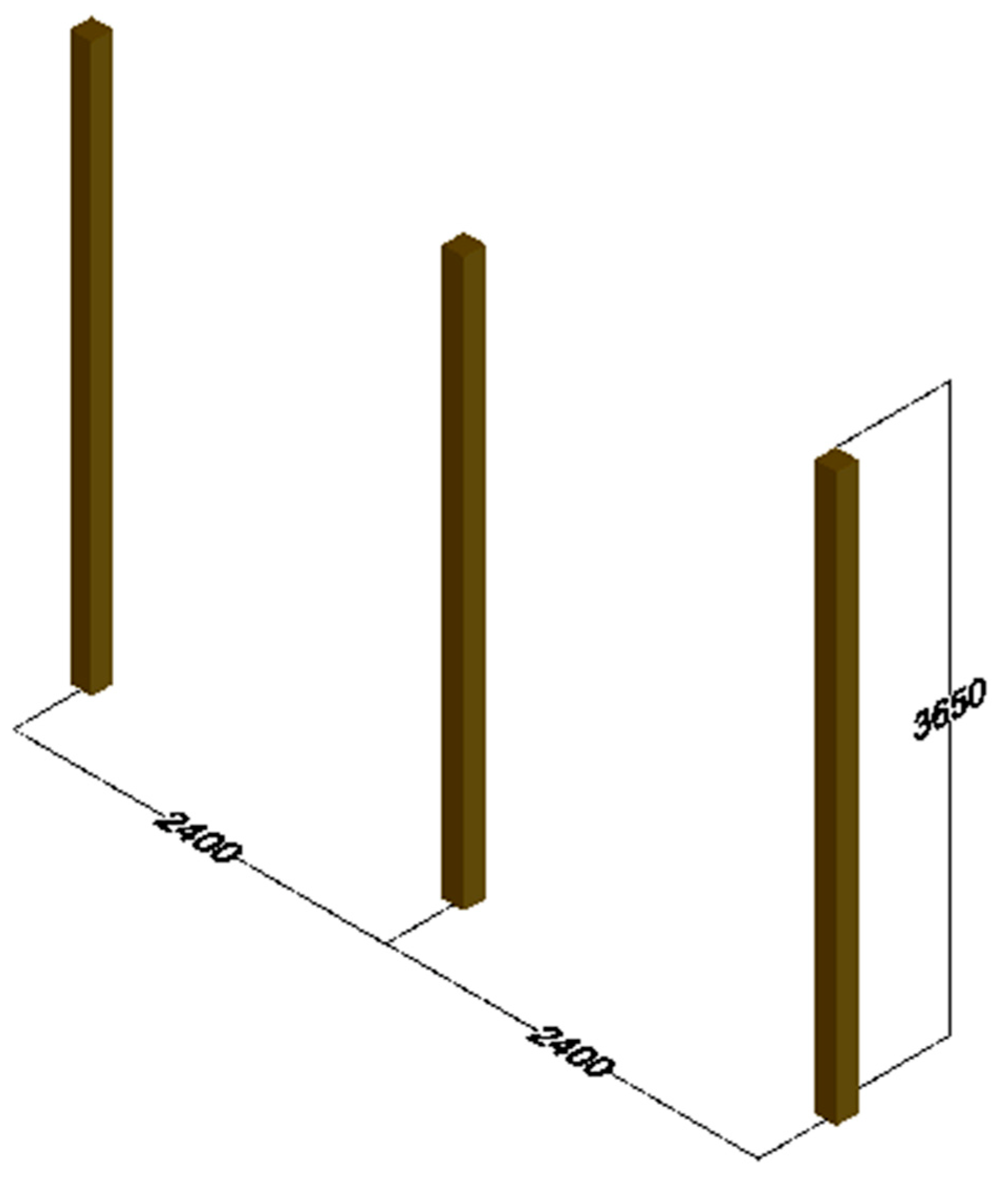
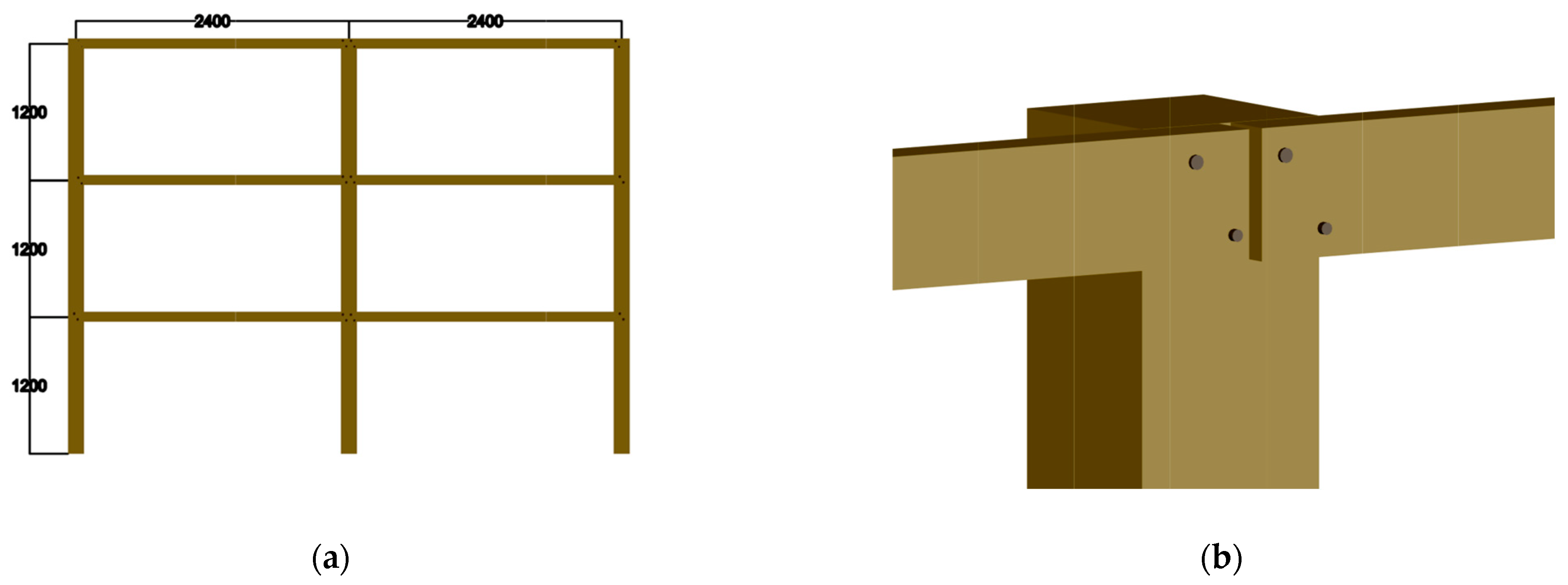

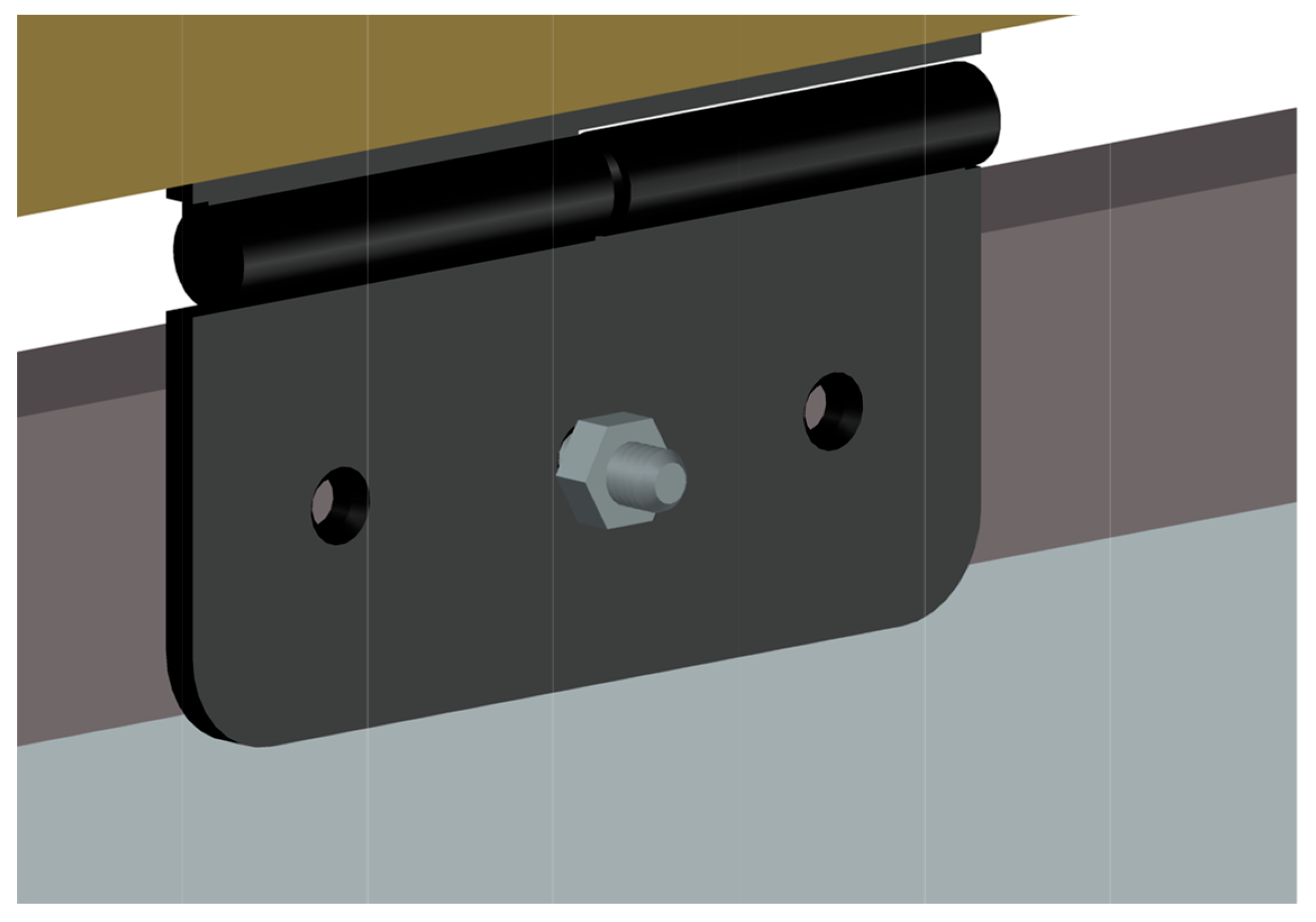
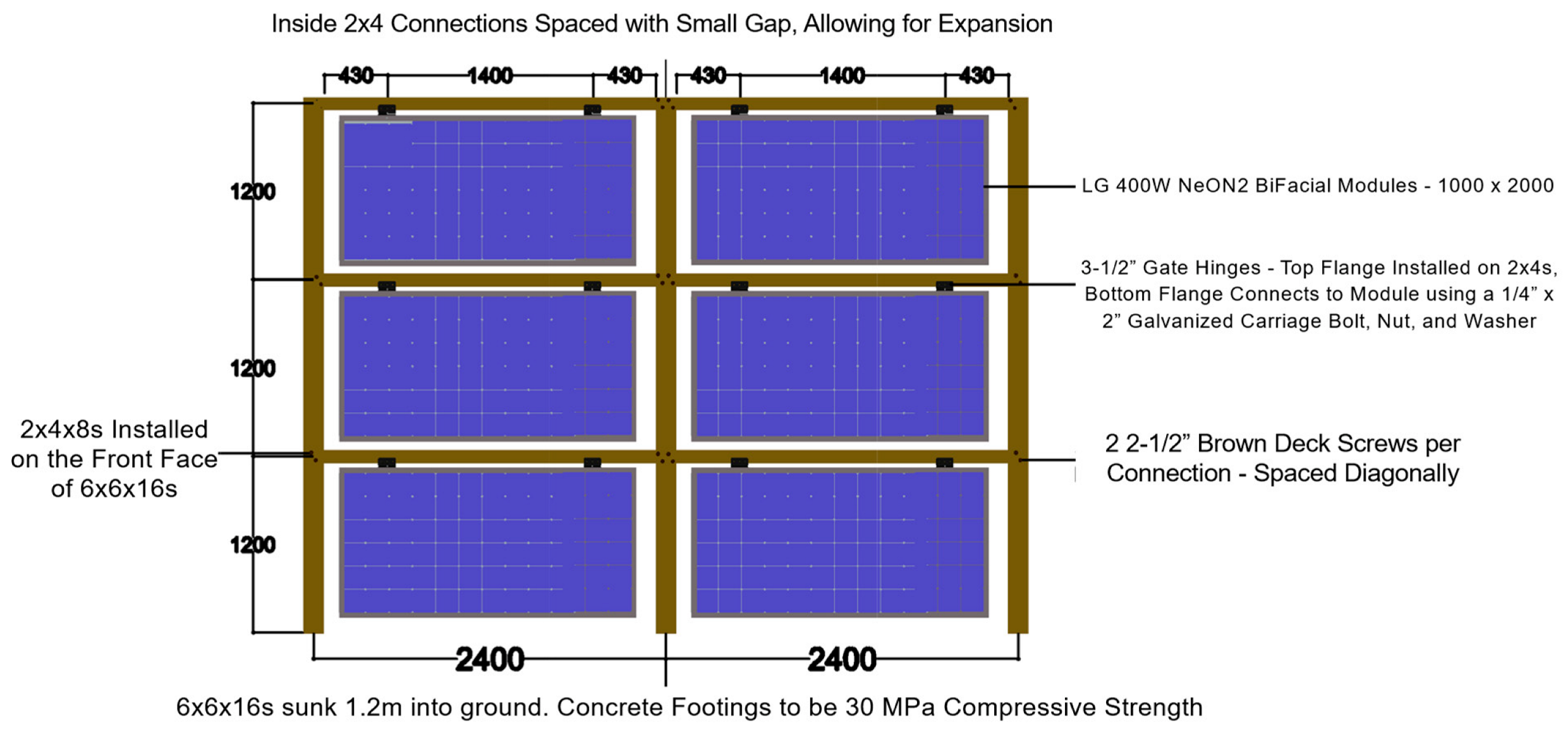
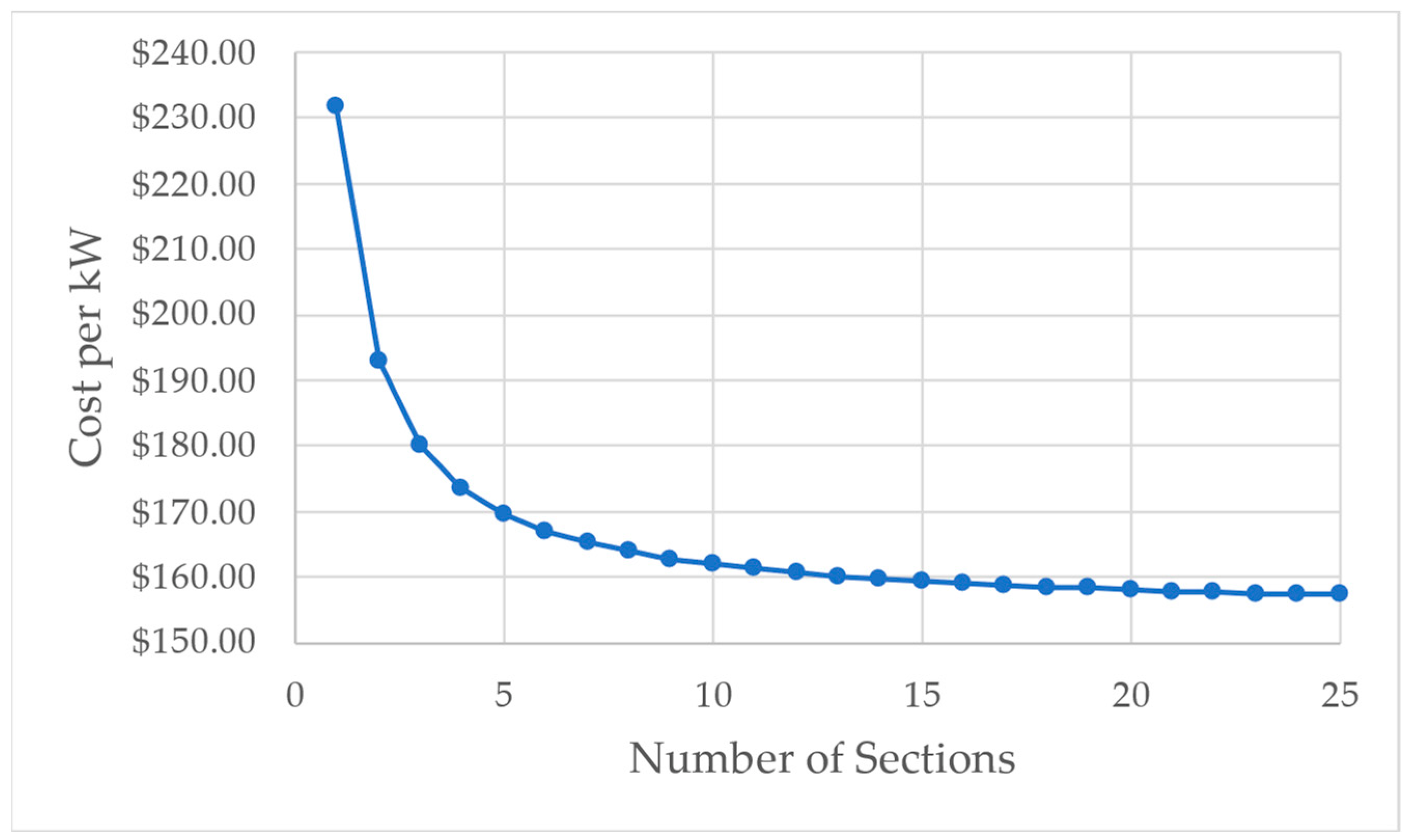
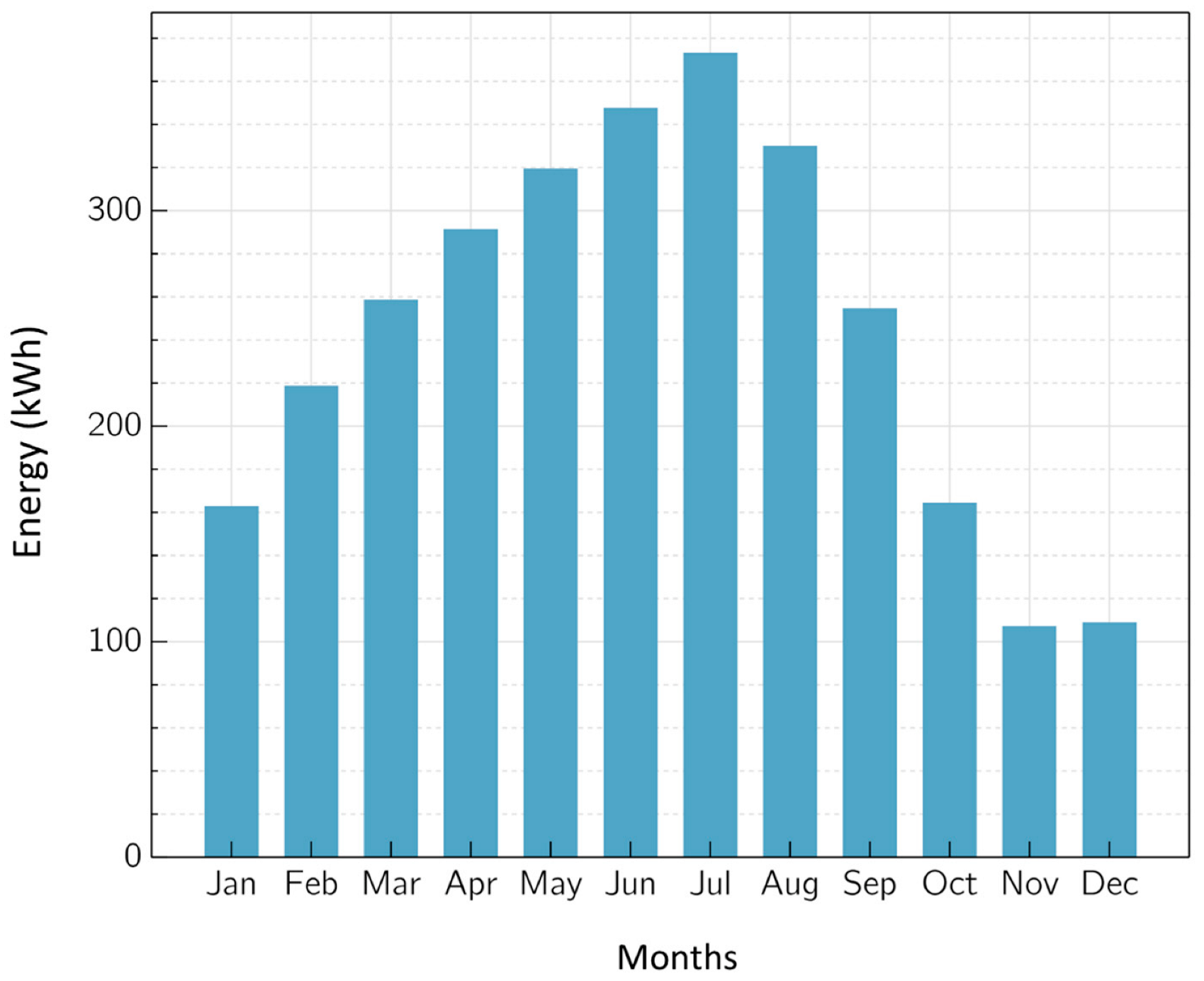
| Member Name | Piece 1 | Cost per Piece 2 | Quantity | Cost |
|---|---|---|---|---|
| Posts | 6 × 6 × 16 | CAD 93.00 | 2 | CAD 186.00 |
| Beams | 2 × 4 × 8 | CAD 10.54 | 3 | CAD 31.62 |
| Module to 2 × 4 Hinges | 3-1/2″ Gate Hinges | CAD 9.51 | 6 | CAD 57.06 |
| 2 × 4 to Module Connections | ¼″ Carriage Bolt (1-1/2″), Nut, and Washer | CAD 0.48 | 6 | CAD 2.88 |
| 2 × 4 to Post Connections | 2-1/2″ Brown Deck Screws | CAD 0.04 3 | 12 | CAD 0.48 |
| Total Cost Without Concrete | CAD 278.04 | |||
| Concrete for the Posts | 30 MPa commercial Quikrete concrete | CAD 5.40 | 4 Bags | CAD 21.60 |
| Total Cost: | CAD 299.64 |
| Parameter | Value | Reference |
|---|---|---|
| PV Module | LG Electronics Inc. LG400N3C-V6 | [73] |
| Cell Type | Monocrystalline Silicon (Bifacial) | [73] |
| Number of Modules | 6 | This Study |
| Tilt Angle | 90° | This Study |
| Azimuth | 90° | [74] |
| DC Power Rating | 2.4 kW | This Study |
| Inverter AC Power | 2.5 kW | [70] |
| DC to AC Ratio | 0.96 | This Study |
| Soiling Losses | 1% | This Study |
| DC Power Losses | 4.44% | [70] |
| Lifetime | 25 years | [75] |
| Annual PV Degradation Rate | 0.5% | [76] |
| Shading | No | This Study |
| Racking System (2.4 kW) | Lifetime Energy (kWh) | Racking Cost (CAD) | Racking LCOE (CAD/kWh) | Racking Cost per Watt (CAD/W) |
|---|---|---|---|---|
| Wood Fixed Tilt [58] | 80,130 | CAD 768.00 | CAD 0.0096 | CAD 0.32 |
| Wood Seasonal Tilt [59] | 84,304 | CAD 816.00 | CAD 0.0097 | CAD 0.34 |
| Commercial Metal Vertical Tilt 1 [63] | 68,940 | CAD 656.00 | CAD 0.0095 | CAD 0.27 |
| Proposed Vertical Wood Racking | 68,940 | CAD 505.08 | CAD 0.0073 | CAD 0.21 |
Disclaimer/Publisher’s Note: The statements, opinions and data contained in all publications are solely those of the individual author(s) and contributor(s) and not of MDPI and/or the editor(s). MDPI and/or the editor(s) disclaim responsibility for any injury to people or property resulting from any ideas, methods, instructions or products referred to in the content. |
© 2023 by the authors. Licensee MDPI, Basel, Switzerland. This article is an open access article distributed under the terms and conditions of the Creative Commons Attribution (CC BY) license (https://creativecommons.org/licenses/by/4.0/).
Share and Cite
Vandewetering, N.; Hayibo, K.S.; Pearce, J.M. Open-Source Vertical Swinging Wood-Based Solar Photovoltaic Racking Systems. Designs 2023, 7, 34. https://doi.org/10.3390/designs7020034
Vandewetering N, Hayibo KS, Pearce JM. Open-Source Vertical Swinging Wood-Based Solar Photovoltaic Racking Systems. Designs. 2023; 7(2):34. https://doi.org/10.3390/designs7020034
Chicago/Turabian StyleVandewetering, Nicholas, Koami Soulemane Hayibo, and Joshua M. Pearce. 2023. "Open-Source Vertical Swinging Wood-Based Solar Photovoltaic Racking Systems" Designs 7, no. 2: 34. https://doi.org/10.3390/designs7020034
APA StyleVandewetering, N., Hayibo, K. S., & Pearce, J. M. (2023). Open-Source Vertical Swinging Wood-Based Solar Photovoltaic Racking Systems. Designs, 7(2), 34. https://doi.org/10.3390/designs7020034








